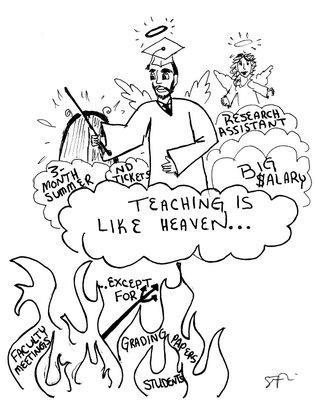Week Eight, Part 2 - CivPro: Motion To Dismiss
 In Civil Procedure, Professor Joseph Bauer discusses the mock mid-term scheduled for Thursday night. With a slight smile and his chin cocked up, he seems to enjoy our anxiety.
In Civil Procedure, Professor Joseph Bauer discusses the mock mid-term scheduled for Thursday night. With a slight smile and his chin cocked up, he seems to enjoy our anxiety.“There will be an extended fact pattern dealing with a court’s attempt to exercise personal jurisdiction over a non-resident defendant,” Bauer says. “You’ll need to recognize the issues and identify the applicable rules.”
He strokes his beard, as if deep in thought. “Two suggestions. First, your answer isn't as important as how you got there. Second, simply repeating the facts is not a good way to start. Facts only become relevant as you integrate them into your analysis.”
Bauer will mark our tests over fall break, the one-week vacation starting Friday at noon. “Teaching is like heaven,” he says, “except for faculty meetings and grading papers.”
We laugh, more nervous than amused.
Bauer waits for us to quiet down, then begins the regular class work. “For the last seven weeks, we’ve learned what constitutes sufficient personal jurisdiction. Today we begin a new section – challenges to jurisdiction. We’ll also look at the Federal Rules of Civil Procedure.”
Bauer questions a student about the facts and procedural history in Harkness v. Hyde, a case from 1878. I expect the Socratic dialogue to resolve the legal question of “whether an American Indian on the Shoshonee reservation is subject to the personal jurisdiction of an Idaho court.”
No! After noting the court’s reference to his favorite case, Pennoyer v. Neff, Bauer primarily wants to discuss whether the defendant could on appeal object to jurisdiction. Put in compound-complex Bauer-talk, “If a party a) makes an objection to jurisdiction, here by special appearance, and b) if that objection to jurisdiction is overruled or rejected, and c) and the case is then litigated on the merits, has the party waived its objection to jurisdiction on appeal?”
In my brief, I’ve totally missed Bauer’s main point. I’m ice-cold at the thought that Bauer could have drilled me. Gotta do better, I think. No more book briefs while watching cartoons!
Bauer holds up our supplementary text, the Federal Rules of Civil Procedure. It’s a green paperback, about 700 pages long. On the cover is a black and white picture of the Supreme Court building.
“For the bulk of the history of the federal courts, there were no special rules of procedure,” he says. Bauer’s in lecture mode and everyone relaxes. “Each court used the rules of the state in which it was situated.”
Bauer summarizes the 1934 Rules Enabling Act. It authorized the Supreme Court to promulgate uniform rules for federal courts.
“Since 1938, over half the states have rules modeled closely on these,” Bauer says. As is the norm, he mentions nothing about Indiana in particular.
Bauer reads aloud Rule 12(b) and explains the subsections which deal with lack of jurisdiction. We then turn to “Form 19,” titled “Motion To Dismiss, Presenting Defenses Of Failure To State A Claim, Or Lack Of Service Of Process, Or Improper Venue, And Or Lack Of Jurisdiction Under Rule 12(B).” It’s the first legal form we’ve seen all year.
Bauer reads the first sentence: “The defendant moves the court as follows:” He looks up and waits for eye contact. “A party moves, it doesn't motion.”
I’m hungry and tired of thinking. It’s almost time to go. Students begin to shift in their chairs and click their pen caps shut.
A student in the fourth row, Scott Delaney, raises his hand. He’s a former disc jockey with no fear of expressing himself. “Motion to dismiss?”
The class laughs at this challenge to jurisdiction. Students behind Delaney clap their hands.
Bauer thinks for a second, then smirks. “Granted.”
* * *

0 Comments:
Post a Comment
<< Home